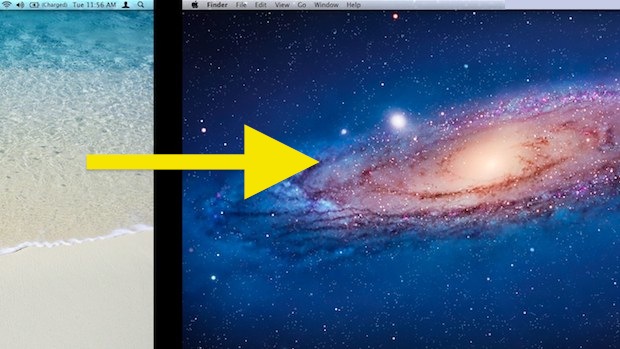In Between The Space Mac OS
- What Is The Latest Mac Os
- In Between The Space Mac Os Catalina
- In Between The Space Mac Os 11
- In Between The Space Mac Os 7
| Click here to return to the '10.5: Drag and drop between Spaces' hint |
- Use the trackpad. To switch between spaces on a Mac with a trackpad, swipe left or right on the pad with a four-fingered gesture. This will cycle you through the open spaces in your chosen direction.
- The “Other” category in the About This Mac window may sometimes be big. However, this isn’t always a problem. But if you’re running low on storage space on your Mac, there are ways to fix the “Other” category from taking up so much space. Here is how: How to remove “other” data in macOS and OS X Easy steps to delete other data.
A third way, and one that partially solves Robs issue, is to have Spaces assigned to a corner, then drag the item from one app, to the hot corner, then to the second space, hover over the space 'till it springs, then drop.
Rob's right that it springs back to the source space if you drag to an application, but if you drag to finder or the desktop it appears to stay at the destination space after dropping.
Mark
A fourth way is to simply drag any window to the edge of the screen. Keep holding the mouse button down and after a short pause, you'll move to the next space.
To move an app or window to a different Space, enter Mission Control and drag the window into the desired Space. To move an open window to an adjacent space, drag the window to the side of your. Mar 27, 2019 Now when you hit the space bar twice, or type a double-space, a period will no longer be inserted automatically. Instead, to type a period you must manually hit the period key on the Mac keyboard. For some Mac users this is entirely a matter of personal preference, but there are situations where this period typing shortcut can be problematic. The most basic way to check free disk space on a Mac is by using Finder. Open a new Finder window by pressing Command+N or selecting File New Finder Window in the menu bar. (You can also use a little-known shortcut to open one from anywhere.) The Best Tech Newsletter Anywhere.
Well yes that works for windows, but not for files which is what the hint was about.
How did I miss that? Thank you!!
What Is The Latest Mac Os

If you are a keyboard person, like me, make sure you have keyboard shortcuts set up in the Spaces preferences. I use Command-Option- number keys.
Start to drag a window or item, hit Command-Option-3 to go to the 3rd space, drop where you need it.
Much easier IMHO, and no snapbacks.
Or, if you are wanting to drop an item (text, picture, whatever) into an application, make use of the spring loaded dock feature.
---
Aluminum iMac 20' 2.4 GHz/3GB/300GB HD
I'm amazed how simple Apple made dragging between spaces...
I was shocked when I missed the window i was dragging, and dragged the Space itself. you can reorder the Spaces themselves by dragging.
| Click here to return to the 'Insert non-breaking spaces' hint |
In Between The Space Mac Os Catalina
That's been around as long as I can remember, I think in the pre-OS X days as well. I can only test it in Classic right now, but yes, it works there.
Yes, it was already there before Mac OS X, and with international keyboard layouts as well.
I'm not sure how far back this goes, …
It goes back to System 1.0.
In MS-Word (only) it is CMD-SHIFT-<hyphen> to create a non-breaking hyphen.
Non breaking hyphen us unicode u2011 - I'm not sure if it has a normal keyboard way of entering it, but if you choose the 'Unicode Hex Input' input method, you can do opt+2011 to enter it.
A bit clumsy though.
---
~/.sig: not found
Woah. I am surprised this isn't in here yet. This has definitely been around since the classic days, maybe even System 1.0 as another commenter suggests.
Option-Space also sometimes lets you type a space character when the spacebar would otherwise do something else, such as selecting the first item in a folder instead of activating Quicklook in the Leopard Finder (I think this hint was posted here). Ditto for selecting playlists in iTunes instead of play/pausing (I don't know if that has been hinted. Fair game if it hasn't).
In Between The Space Mac Os 11

In Between The Space Mac Os 7
I'm not sure how far back this goes, but on Leopard at least, pressing Option-Space on the US or US Extended keyboard layouts inserts a non-breaking space (U+00A0) rather than a normal space (U+0020).This has been the rule on French keyboards since... but it's broken in Mail.app in Leopard (I never used Mal.app before TimeMachine and the fact that a big mail database is a Go hog in backups). Mail.app 3 inserts normal spaces instead of non breaking spaces and it's frustrating. In French you insert non-breaking spaces before '; : ? !' and » and after «. So you get punctuation marks at the beginning of lines and that's not very clean, to say the least.
In OS X, you can easily create new shortcuts.
Create a file called: ~/Library/KeyBindings/DefaultKeyBinding.dict
using a plain text editor.
Add a line like:
'^`' = ('insertText:', '‑'); /* nbhy */
This means 'Control-` generates a command to insert a non-breaking hyphen character.
You can also insert a whole word, which is good for words or sequences of words you type often that are long like:
'^M' = ( 'insertText:', 'Massachusetts' );
'^N' = ( 'insertText:', 'New Hampshire' );
which means Control-M (not Control-m) inserts Massachusetts.
You can also use 2 character sequences, like
'^s' = {
'^c' = ('insertText:', '✔');
'^x' = ('insertText:', '✘'); /* X Symbol */
'^1' = ('insertText:', '¹'); /* superscript 1 */
'^2' = ('insertText:', '²'); /* superscript 2 */
'^3' = ('insertText:', '³'); /* superscript 3 */
};
Then Control-s followed by Control-c enters a check mark, etc.
Yes, this also be used for commands like:
'^a' = 'deleteToBeginningOfParagraph:';
which is similar to the built-in Control-k command (delete to end of paragraph and put it in the yank buffer).
Or to move the cursor right by 7 words:
'^UF703' = (
'moveWordForward:',
'moveWordForward:',
'moveWordForward:',
'moveWordForward:',
'moveWordForward:',
'moveWordForward:',
'moveWordForward:'
);
I get endless amusement out of this kind of thing.